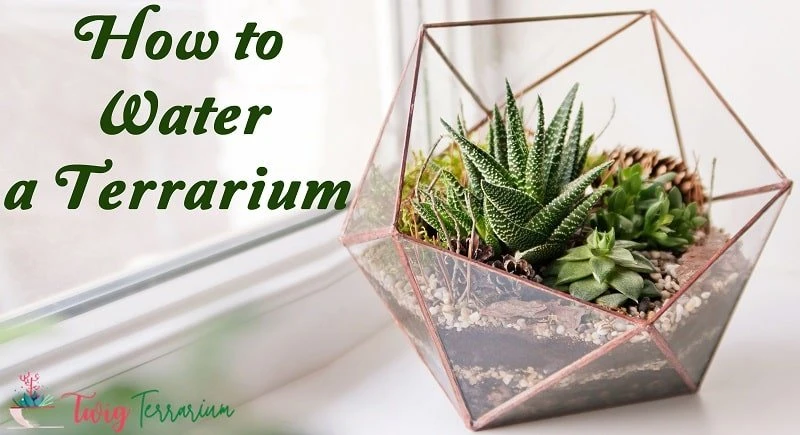reviewed by Truman Perkins
It is essential to bear in mind that terrarium ecosystems operate on an outstanding balance. Inadequate or excess water can have an impact on the ecosystem. Excess water means you are subjecting your terrarium to rot and mold. Too little water implies that your plants may die.
Every terrarium requires unique watering needs, but there are some standard practices to follow to have the best chance of getting it just right.
Contents
Knowing precisely when to water a terrarium is a vital aspect of your plants’ wellbeing. It is not advisable to leave your terrariums unattended for quite long. Try to water them often as the situation dictates.
Here are the circumstances under which you should add water to a terrarium.
Most terrariums house tropical plants that need a humid environment to survive. Therefore, a substrate that has excellent water retention and perfect drainage is critical. A substrate should always be moist to allow a proper function of the ecosystem.
You can confirm whether the substrate is moist by touching it or checking the condensation level against the glass through the substrate level. A moist substrate will display some condensation throughout the time.
When there is no visible condensation in a terrarium, it is time to water it. A closed terrarium with an effective water cycle should show some condensation throughout the container at specific points throughout the day.
If there is a lack of condensation throughout the top of a terrarium, there is inadequate water in the system.
It is crucial to fix any dryness issues before your plants start yellowing or wilting leaves.
When plants are struggling with a lack of water, they will start fading and wilting their leaves.

There is no fixed schedule for watering terrariums. Therefore, a balance has to be struck between rarely and frequently. Rare watering implies that you are not over-saturating the substrate, and frequent watering means that you are not allowing the ecosystem to have an independent, healthy water cycle.
The frequency of watering your terrarium depends on several factors, such as the size of the terrarium, materials, and the nature of the environment.
As long as you have added the right amount of water to maintain an ideal water cycle, you can have a rough idea of when to add it again. It may be once or twice a month.
Here is what you need to know about watering a terrarium.
It is advisable to use a mister or an ordinary water bottle with a display function to carry out the task.
If you let water out of a bottle or tap directly, you will flood some areas and neglect others. You have to distribute water evenly, and if some areas demand more water, spray them directly.
Having effective watering tools will make your work more comfortable and convenient. Regardless of your terrarium size, consider using a high-quality water bottle with an adjustable spray nozzle.
Knowing the ideal amount of water to use can be tricky if you are inexperienced. If you want to accomplish the best saturation, add a moderate amount of water gradually while leaving the moisture to permeate.
Knowing which water to use is critical for the health of your terrarium plants. Direct water from the tap has some chlorine, and it is not ideal for watering. Before you use the tap water, let it sit for about 24 hours for the chlorine to evaporate off.
Here is an overview of the best types of water to use.
Reverse osmosis water: It is pure but overpriced
Distilled water: pure but relatively expensive
Deionized water: This is water without salt. It is ideal for your terrarium watering.
An open terrarium features bonsai trees and different small terrarium plants like fittonia, Syngonium, selaginella, etc. These plants are organized to create a living world in a glass.
When watering an open terrarium, it is vital to consider the terrarium’s position. Open terrariums should be placed in bright spots where they get indirect light. During the summer, keep your terrarium away from the hot window.
When it is too hot, you may need to water your terrarium daily. If that seems challenging to you, consider watering it every two days in summer and every five days in winter.
You can use a spray mister to water your terrarium, but don’t forget to wipe down your glass after the exercise.
Watering succulents can be challenging if you haven’t dealt with the plants before. As opposed to what people believe, succulents do require water. Although these plants can survive for an extended period with little water, they may not look beautiful unless watered. If you want to have healthy succulents, you have to create a watering schedule.
Note that succulents are adapted to survive in arid and semi-arid conditions. However, do not allow succulents to become completely dry. It is recommended to water them adequately and then wait for the soil to dry out before you water them again.
In summer, assess their dryness every 2-3 weeks, and in winter, check for dryness every 3-4 weeks.
When watering, spray water around a plant’s base but not over the succulent because the plants don’t like mist. Always use non-chlorinated water and place your plant in a brighter area for adequate light.
A closed terrarium is an independent system that can maintain the required level of moisture with little water. The plants’ moisture condenses on the ceiling and sides of the glass, recycling the droplets back as rain. This way, the plants can thrive in their environment.
If there is excess moisture in the terrarium, wipe it out since it can result in plants’ rotting. Additionally, you can open the lid to ventilate the terrarium, but don’t leave it open for quite long. If you don’t see any moisture on the side or lid, it means the terrarium is dry and needs watering. Therefore, you can water it using a baster with non-chlorinated water.
Watering a closed terrarium is straightforward. Start with little water and let it trickle down slowly to the base roots of plants. After that, wait for a few weeks to see whether the moisture cycle begins. Note that once there is an ecosystem establishment, you will only need to water it once or twice a year.
When watering your terrarium, avoid aiming at the surface of the plant or leaves. This can damage your fragile plants or affect their growth position and design. Instead, spray water on the soil and to the plants’ sides while pausing to ascertain the extent of wetness.
Avoid watering your plants when you spot condensation on the glass surface. Note that plants breathe, and through photosynthesis, they produce condensation, which increases heat in the terrarium. This condensation will finally drop down and water the soil again.
Plants are different, and they need various ways of watering. For instance, air plants require light spraying, so don’t spray them using a high-powered water stream. However, succulents can cope with a higher stream spray, but not on their leaves either.
Underwatering and overwatering of plants do happen, and you need to know to identify them. Underwatering signs include falling leaves. If you spot brown spots on leaves, increase the amount of your watering.
The overwatered succulents have weak white or yellow leaves. The primary sign of overwatering is dead roots because of a deficiency of oxygen.
Watering terrariums is an essential aspect of maintaining their health. The frequency of watering is dependent on season, which is why more watering is done in summer than winter. As you water your plants, bear in mind that terrariums don’t have drainage systems, and it can be challenging to remove excess water.
Ensure that the soil is kept moist but not wet. This will make your plants healthy, but excess watering will damage the root system and even result in the death of a plant.
Top Tips for Caring a Terrarium
Here are the tips on how to care for a terrarium
 |
 |
 |
 |

About Truman Perkins
Truman Perkins is a Detroit-based SEO consultant who's been in the business for over a decade. He got his start helping friends and clients get their websites off the ground, and he continues to do so today. In his free time, Truman enjoys learning and writing about gardening - something he believes is a natural stress reliever. He lives with his wife, Jenny, and their twins in Detroit.
 |
 |
 |
 |
Get new FREE Gifts. Or latest free growing e-books from our latest works.
Disable Ad block to reveal all the links. Once done, hit a button below
 |
 |
 |
 |